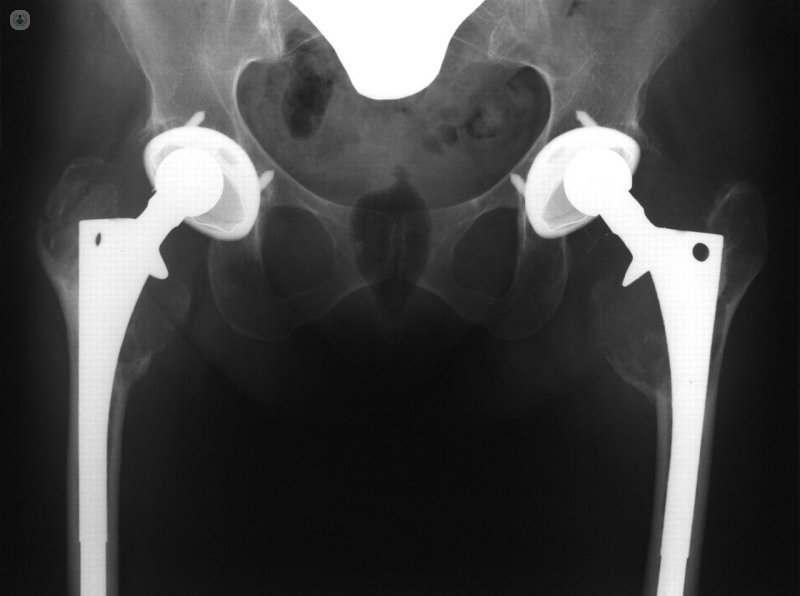"The first day with hip replacement patient walks with crutches"
Written by: From ancient postoperative 4-6 months we have passed current of 4 to 6 weeks. Advances in prosthetic surgery has revolutionized recovery times and the duration of the prosthesis. Dr. Rafael Gonzalez-Adrio, prosthetic surgery expert, explains the latest innovations in prosthesis placement.
From ancient postoperative 4-6 months we have passed current of 4 to 6 weeks. Advances in prosthetic surgery has revolutionized recovery times and the duration of the prosthesis. Dr. Rafael Gonzalez-Adrio, prosthetic surgery expert, explains the latest innovations in prosthesis placement.
Doctor, what are the latest developments in prosthetic surgery?
We can talk about two major advances in limb-fitting: progress in making materials themselves prosthesis and evolution in the techniques to implement them. Today, the materials are increasingly resistant to wear, making the prosthesis more durable. Our contribution as surgeons is to put them in the best way possible, so that not only work better and there are fewer complications in the short and medium term, and we will make it last longer. To help do this and reduce the margin of error by placing, we use a browser.
What exactly does the browser?
The browser reproduces the patient's joint in a computer. On your screen you can decide the type and size of the prosthesis you need and the exact position in which we must implement it and then we guide their placement.
In the same operation, doctor?
Yes, as we open and expose the joint operating room we introduce a series of markers on the bone. We have some cameras that detect these markers and a computer processes the information we give you on the morphology of the joint and the position of the bones in space. On the computer screen, the software draws a reproduction of the patient's joint, and on that virtual articulation can decide the type of prosthesis, size and position and angle at which we place. That is, we can see a virtual replica of the implanted prosthesis at the joint, with angle and distance information between the bones in order to decide the best position and play in real articulation. From there, once you have decided how and where, the browser leads you through markers that exist in our instruments and is able to detect, to implement it in a determined position.
What advantage presents?
Thanks to this browser we can be much more precise placement of the prosthesis in the position that we consider perfect. Thus we get the implant works better, there is less risk of dislocation, avoid unwanted elongation of the limb and that in the long term, there is less wear of materials. The browser also helps us a lot to prevent asymmetries. It's like you fit the wheel of a car, if it is misaligned wear will be higher in any of the sides, not only worse but also work last less. Conversely, if the wheel is installed well, it will work better and last longer rubber kilometers.
Is the browser to the knee can also be used?
We have also used navigation for knee surgery but increases too much time in the operating room. However, we have perfected with another solution: before the intervention requested a special MRI of the knee and sent a team of engineers who have previously specified the position and the angles at which we want to work the prosthesis. They made us a three-dimensional molds tailored to each patient; during surgery these molds placed on the bone and make cuts on the mold itself. This allows us to be much more precise placement of the prosthesis and also to the intervention in less time: avoids making period measurements with less blood loss, because it does not enter into the medullary canal of the femur or tibia.
Anyone patient can be operated using the browser?
Virtually all except when large materials that prevent deformities or obtaining image data.
And recovery after surgery accelerates?
Today, with these techniques, we got a very solid and stable implementation since its placement in surgery. In addition, very rarely blood transfusion is needed, so hospitalization is very short. In 3 or 4 days the patients go home with oral analgesics may be used usually with a headache.
On the prosthesis, what material are we talking?
Today prostheses are designed with a similar metal to that of bone porosity. Thus we get that integration more quickly and reliably, without using cement. As the friction surfaces of the prosthesis, where motion and wear occurs, we use four different materials:
• Metal polyethylene is used for older people with less physical activity expectations.
• ceramic pottery, more active patients but made no impact activities such as running or jumping, which involve a risk of breaking pottery.
• Metal with metal hip resurfacing in young patients who want all kinds of physical activities. With the latter have excellent results in men, young, active, with survival of the prosthesis close to 100% of cases over 10 years of follow up.
Today the goal is to make the prosthesis lasts more than 30 years to avoid, especially in very young patients, multiple parts throughout his life.
Where advance innovations in prosthetic surgery?
By placing easier to put on and more resistant increasingly less invasive implants wear. The future is in ceramizados metals other than brittle and highly resistant to breakage of the material. Ceramic is the hardest material but also one of the most fragile. The objective is to obtain materials with the hardness of the ceramic wear resistance, but its fragility.


